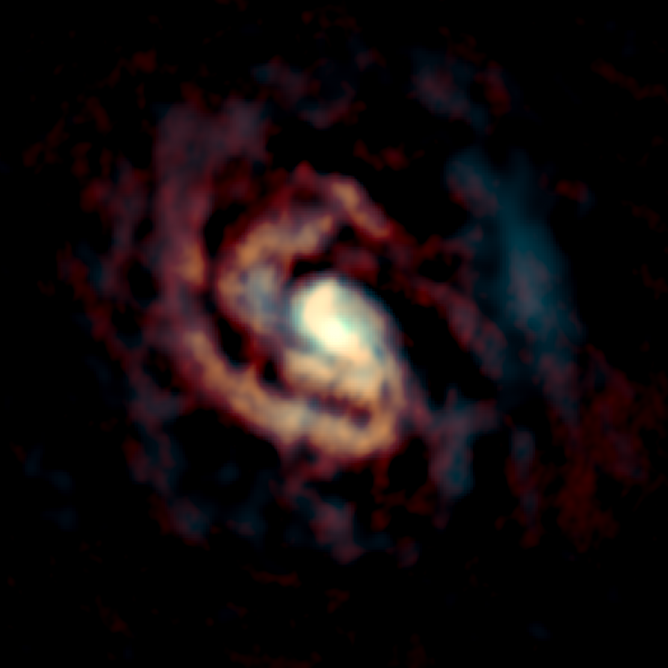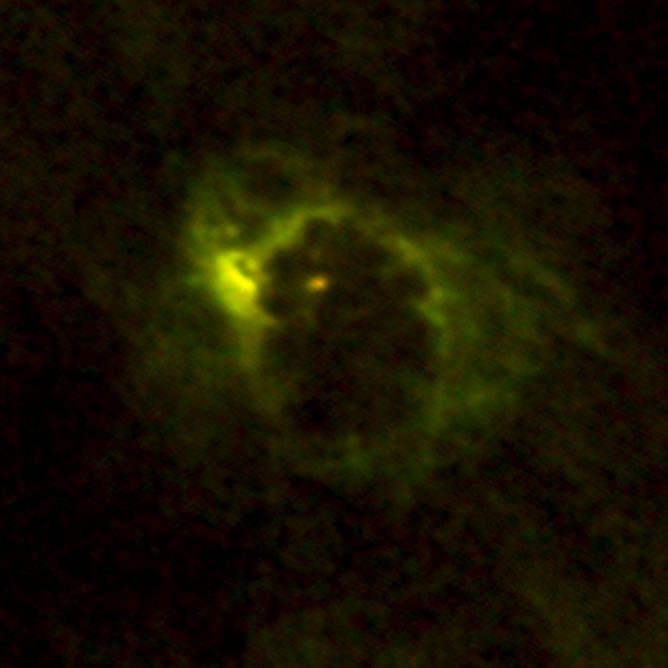Researchers from RIKEN and JAXA have used observations from the ALMA radio observatory located in northern Chile and managed by an international consortium including the National Astronomical Observatory of Japan (NAOJ) to measure, for the first time, the strength of magnetic fields near two supermassive black holes at the centers of an important type of active galaxies. Surprisingly, the strengths of the magnetic fields do not appear sufficient to power the “coronae,” clouds of superheated plasma that are observed around the black holes at the centers of those galaxies.
It has long been known that the supermassive black holes that lie at the centers of galaxies, sometimes outshining their host galaxies, have coronae of superheated plasma around them, similar to the corona around the Sun. For black holes, these coronae can be heated to a phenomenal temperature of one billion degrees Celsius. It was long assumed that, like that of the Sun, the coronae were heated by magnetic field energies. However, these magnetic fields had never been measured around black holes, leaving uncertainty regarding the exact mechanism.
In a 2014 paper, the research group predicted that electrons in the plasma surrounding the black holes would emit a special kind of light, known as synchrotron radiation, as they exist together with the magnetic forces in the coronae. Specifically, this radiation would be in the radio band, meaning electromagnetic waves with a long wavelength and low frequency. And the group set out to measure these fields.
They decided to look at data from two “nearby,” in astronomical terms, active galactic nuclei: IC 4329A, which is about 200 million light-years away, and NGC 985, which is approximately 580 million light-years away. They began by taking measurements using the ALMA observatory in Chile, and then compared them to observations from two other radio telescopes: the VLA observatory in the United States and the ATCA observatory in Australia, which measure slightly different frequency bands. The team found that indeed there was an excess of radio emission originating from synchrotron radiation, in addition to emissions from the “jets” cast out by the black holes.
Through the observations, the team deduced that the coronae had a size of about 40 Schwarzschild radii, the radius of a black hole from which not even light can escape, and a strength of about 10 gauss, a figure that is a bit more than the magnetic field at the surface of the Earth but quite a bit less than that given out by a typical refrigerator magnet.
“The surprise,” says Yoshiyuki Inoue, the lead author of the paper, published in The Astrophysical Journal, “is that although we confirmed the emission of radio synchrotron radiation from the corona in both objects, it turns out that the magnetic field we measured is much too weak to be able to drive the intense heating of the coronae around these black holes.” He also notes that the same phenomenon was observed in both galaxies, implying that it could be a general phenomenon.
Looking to the future, Inoue says that the group plans to look for signs of powerful gamma rays that should accompany the radio emissions, to further understand what is happening in the environment near supermassive black holes.
This press release was originally issued from RIKEN.
Paper and Research team
These observation results were published as Inoue and Doi “Detection of Coronal Magnetic Activity in Nearby Active Supermassive Black Holes”, in the Astrophysical Journal in December 2018.
This research was supported by JSPS KAKENHI (No.JP16K13813) and program of Leading Initiative for Excellent Young Researchers, MEXT, Japan.
About RIKEN
RIKEN is Japan’s largest research institute for basic and applied research. Over 2500 papers by RIKEN researchers are published every year in leading scientific and technology journals covering a broad spectrum of disciplines including physics, chemistry, biology, engineering, and medical science. RIKEN’s research environment and strong emphasis on interdisciplinary collaboration and globalization has earned a worldwide reputation for scientific excellence.
About the RIKEN Interdisciplinary Theoretical and Mathematical Sciences Program
The RIKEN Interdisciplinary Theoretical and Mathematical Sciences (iTHEMS) research program is an international center where researchers in theoretical, mathematical, and computational science come together, using mathematical methods, to unravel mysteries of the Universe, matter, and life, as well as to solve key problems in modern society.
Website: https://ithems.riken.jp/en
About the Atacama Large Millimeter/submillimeter Array (ALMA)
The Atacama Large Millimeter/submillimeter Array (ALMA), an international astronomy facility, is a partnership of the European Organisation for Astronomical Research in the Southern Hemisphere (ESO), the U.S. National Science Foundation (NSF) and the National Institutes of Natural Sciences (NINS) of Japan in cooperation with the Republic of Chile. ALMA is funded by ESO on behalf of its Member States, by NSF in cooperation with the National Research Council of Canada (NRC) and the Ministry of Science and Technology (MOST and by NINS in cooperation with the Academia Sinica (AS) in Taiwan and the Korea Astronomy and Space Science Institute (KASI). ALMA construction and operations are led by ESO on behalf of its Member States; by the National Radio Astronomy Observatory (NRAO), managed by Associated Universities, Inc. (AUI), on behalf of North America; and by the National Astronomical Observatory of Japan (NAOJ) on behalf of East Asia. The Joint ALMA Observatory (JAO) provides the unified leadership and management of the construction, commissioning and operation of ALMA.










